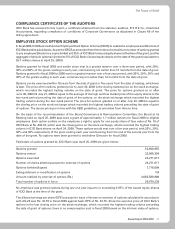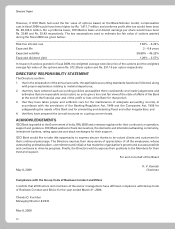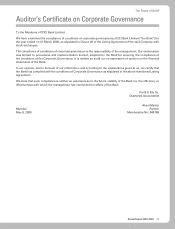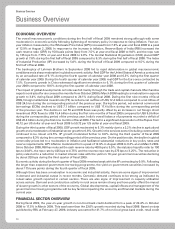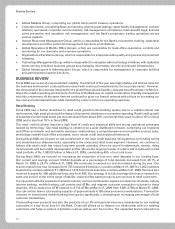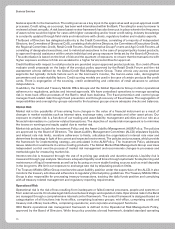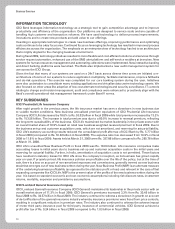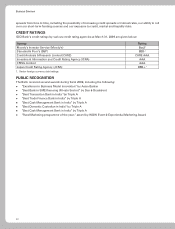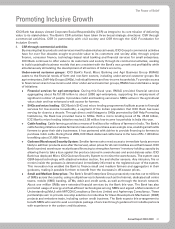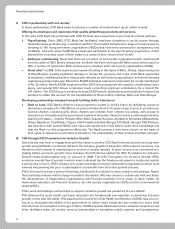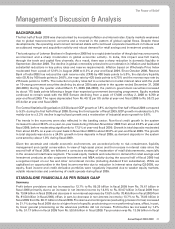ICICI Bank 2009 Annual Report Download - page 38
Download and view the complete annual report
Please find page 38 of the 2009 ICICI Bank annual report below. You can navigate through the pages in the report by either clicking on the pages listed below, or by using the keyword search tool below to find specific information within the annual report.
36
Business Overview
features specific to the transaction. The rating serves as a key input in the approval as well as post-approval credit
processes. Credit rating, as a concept, has been well internalised within the Bank. The rating for every borrower is
reviewed at least annually. A risk based asset review framework has also been put in place wherein the frequency
of asset review would be higher for cases with higher outstanding and/or lower credit rating. Industry knowledge
is constantly updated through field visits and interactions with clients, regulatory bodies and industry experts.
The Board of Directors has delegated authority to the Credit Committee, consisting of a majority of independent
Directors, the Committee of Directors (CoD), consisting of whole time Directors, the Committee of Executives-Credit,
the Regional Committee-Credit, Retail Credit Forums, Small Enterprise Group Forums and Agri Credit Forums, all
consisting of designated executives, and to individual executives in the case of program/policy based products,
to approve financial assistance within certain individual and group exposure limits set by the Board of Directors.
The authorisation is based on the level of risk and the quantum of exposure, to ensure that the transactions with
higher exposure and level of risk are escalated to a higher forum/committee for approval.
Credit facilities with respect to retail products are provided as per approved product policies. Our credit officers
evaluate credit proposals on the basis of the product policy approved by the Retail Credit Forum and the risk
assessment criteria defined by the Global Credit Risk Management Group. These criteria vary across product
segments but typically include factors such as the borrower’s income, the loan-to-value ratio, demographic
parameters and certain stability factors. Credit scoring models are used in the case of certain products like credit
cards. There is segregation of the sourcing, credit underwriting and collection of retail advances to achieve
independence.
In addition, the Credit and Treasury Middle Office Groups and the Global Operations Group monitor operational
adherence to regulations, policies and internal approvals. We have centralised operations to manage operating
risk in most back office processes of the Bank’s retail loan business. The fraud prevention and control group
manages fraud-related risks through fraud prevention and through recovery of fraud losses. The segregation of
responsibilities and oversight by groups external to the business groups ensure adequate checks and balances.
Market Risk
Market risk is the possibility of loss arising from changes in the value of a financial instrument as a result of
changes in market variables such as interest rates, exchange rates, credit spreads and other asset prices. Our
exposure to market risk is a function of our trading and asset-liability management activities and our role as a
financial intermediary in customer-related transactions. The objective of market risk management is to minimise
the losses on earnings and equity capital due to market risk.
Market risk policies include the Investment Policy and the Asset-Liability Management (ALM) Policy. The policies
are approved by the Board of Directors. The Asset-Liability Management Committee (ALCO) stipulates liquidity
and interest rate risk limits, monitors adherence to limits, articulates the organisation’s interest rate view and
determines the strategy in light of the current and expected environment. The policies and processes, which provide
the framework for implementing strategy, are articulated in the ALM Policy. The Investment Policy addresses
issues related to investments in various trading products. The Global Market Risk Management Group exercises
independent control over the process of market risk management and recommends changes in processes and
methodologies for measuring market risk.
Interest rate risk is measured through the use of re-pricing gap analysis and duration analysis. Liquidity risk is
measured through gap analysis. We ensure adequate liquidity at all times through systematic funds planning and
maintenance of liquid investments as well as by focusing on more stable funding sources such as retail deposits
in the long-term. We limit our exposure to exchange rate risk by stipulating position limits.
The Treasury Middle Office Group monitors the asset-liability position under the supervision of the ALCO. It also
monitors the treasury activities and adherence to regulatory/internal policy guidelines. The Treasury Middle Office
Group is also responsible for processing treasury transactions, tracking the daily funds position and complying
with all treasury-related management and regulatory reporting requirements.
Operational Risk
Operational risk is the risk of loss resulting from inadequate or failed internal processes, people and systems or
from external events. It includes legal risk but excludes strategic and reputation risks. Operational risks in the Bank
are managed through a comprehensive internal control framework. The control framework is designed based on
categorisation of all functions into front-office, comprising business groups; mid-office, comprising credit and
treasury mid-offices; back-office, comprising operations; and corporate and support functions.
ICICI Bank’s operational risk management framework is defined in the Operational Risk Management Policy,
approved by the Board of Directors. While the policy provides a broad framework, detailed standard operating



